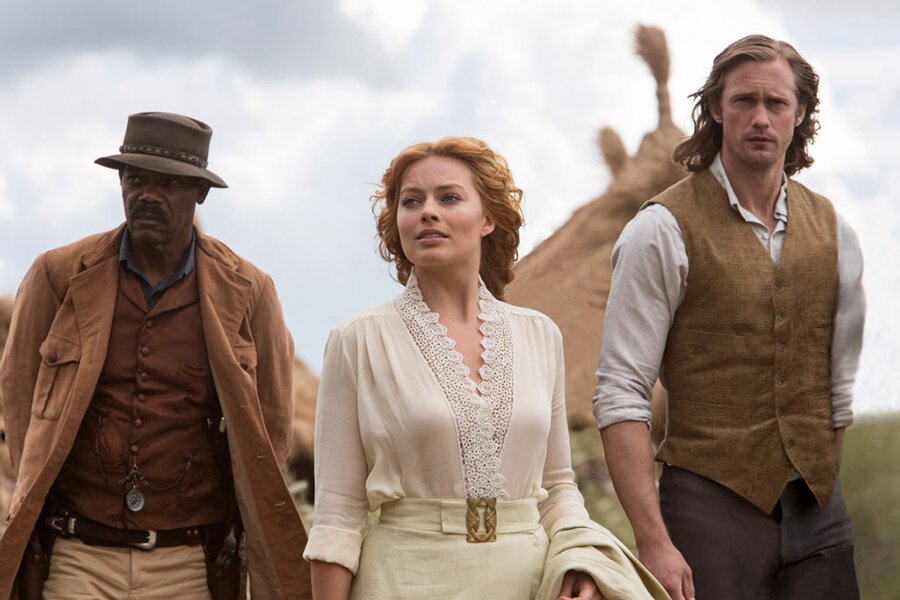Can the story of Tarzan be adapted for contemporary times?
Loading...
Tarzan may be among America's classic fictional characters, but he's not beyond reproach.
Like so many well-worn tales, Edgar Rice Burroughs' Tarzan was borne of a vastly different time more than 100 years ago, when narratives rooted in colonialism, white saviors, and African stereotypes were the norm. Throughout the decades, Tarzan also became a staple of Hollywood – there have been 52 authorized films and seven television series that have told the tales of the King of the Jungle.
For a bygone era, he's the model romantic adventurer. Today, he's a blemish on the history of literature and film.
"The Legend of Tarzan," now in theaters, is the first big-budget studio attempt to take on the character in the modern CGI world. Not only does the Warner Bros. film show feats of derring-do that not so long ago could only be imagined, but it also endeavors to spin a more contemporary story for today's sensibilities.
As with Hollywood's other recent adaptations of beloved tales stories with outmoded values, the "Tarzan" filmmakers did the delicate dance of trying to both preserve its original spirit while also correcting or even discarding its problematic origins. Their approach was to infuse the story with historical perspective, then bake it all into an action-adventure worthy of the superhero generation.
Though there are those who would sooner see Tarzan left for the ages, the character's roots are so deep that they've become archetypal.
"Edgar Rice Burroughs just tapped into a primal myth of humanity," said Scott Tracy Griffin, author of "Tarzan: The Centennial Celebration" and the forthcoming "Tarzan on Film." "He is an orphan who is stranded and must find a way to his manhood and to reclaim his legacy."
Alexander Skarsgård, the latest leading man to do the Tarzan yodel, noted too that "people have always been very fascinated by our more animalistic side and the notion of the noble savage."
He also acknowledged those troubling origins.
"At the time it was written, the way people in Western Europe and in America viewed indigenous people was quite horrific and it was quite common. It was widespread, the notion that they were an inferior race," Skarsgård said. "It was very obviously important to steer away from the notion of, like, the white man coming down to Africa to save all the black people because they can't save themselves ... the movie is about them kicking the colonizing force out of the country."
This film introduces Tarzan at mid-life – already married to Jane (Margot Robbie) and living in England as Lord Greystoke – long past his vine-swinging days. When he receives an invitation from King Leopold to visit the Congo and see the Belgian leader's work there, it's George Washington Williams (Samuel L. Jackson) who convinces him to go and find out what's really happening to the native people.
The injection of Williams – a real-life historian and Civil War veteran who exposed atrocities of the Congo – into the Tarzan mythology helped director David Yates ground it in a historical context. It also helped them turn away from some of the story's less palatable elements.
"It wasn't difficult to jettison those very old-fashioned aspects of the story because it doesn't belong to our century," Yates said.
Jackson sees this Tarzan as purely naturalistic, a character whose unique worldview transcends political mores.
"Even though the enslavement is there and you see it and he's there to right that injustice," he said. "He's part of a world where he is integrated into that society and he understands his place in it ... It's a story of somebody who's environmentally correct and humanly correct with that particular world."
Tarzan has been around so long that adjusting to the times has been as integral to his longevity as hanging vines.
"Producers have been able to tap into whatever is going on in society and put Tarzan into that," said Griffin. In the 1950s, there was a clear Western inspiration in the films, which gave way to a James Bond sensibility in the 1960s, he said.
Even Disney had a take, although that 1999 animated film just sidestepped native populations altogether. "The Legend of Tarzan" is certainly something new, and perhaps the most aggressive effort to right the wrongs, while still keeping Tarzan in the zeitgeist.
Yet there are those who believe Tarzan should be left in the past.
"In some ways it would be like trying to remake 'Gone With the Wind' now," said Todd Boyd, professor of Cinema and Media Studies at the USC School of Cinematic Arts. "It's just a very old set of images rooted in an old history that I think is really hard to redeem ... You can certainly dress it up with technology now. You can also cast it in such a way that it's more diverse. But I just think that some things are perhaps beyond redemption."







